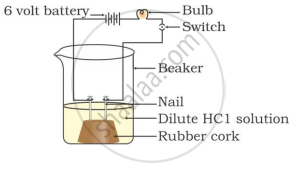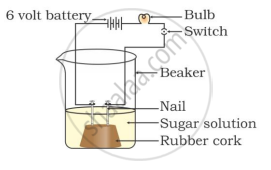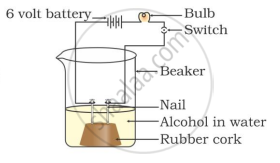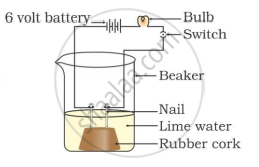Advertisements
Advertisements
Question
While diluting an acid, why is it recommended that the acid should be added to water and not water to the acid?
Solution 1
Since the process of dissolving an acid in water is exothermic, it is always recommended that acid should be added to water. If it is done the other way, then it is possible that because of the large amount of heat generated, the mixture splashes out and causes burns.
Solution 2
- Diluting is a process that involves adding concentrated acid to the water. The concentrated water will be added gradually by stirring.
- There is heat that is evolved slowly and gradually so that concentrated acid is added because diluting acid easily absorbs large quantity of water.
- If it happens in the other way by adding water to diluted acid the amount of heat evolved is all don’t at once and not gradually. This may cause a splash and could end up in acid burn.
APPEARS IN
RELATED QUESTIONS
Compounds such as alcohols and glucose also contain hydrogen but are not categorized as acids. Describe an activity to prove it.
Why does distilled water not conduct electricity, whereas rain water does?
What colour do the following indicators turn when added to a base or alkali (such as sodium hydroxide)?
(a) methyl orange
What colour do the following indicators turn when added to a base or alkali (such as sodium hydroxide)?
red cabbage extract
What colours do the following indicators turn when added to an acid (such as hydrochloric acid)?
methyl orange
Fill in the blank in the following sentences:
Acids produce.......................... ions on dissolving in water.
While diluting an acid, why is it recommended that the acid should be added to water and not water to the acid?
Which gas is liberated when dilute hydrochloric acid reacts with sodium carbonate?
What happens when carbon dioxide gas is passed through lime water for a short time?
Write equations of the reactions involved.
10 mL of a solution of NaOH is found to be completely neutralised by 8 mL of a given solution of HCl. If we take 20 mL of the same solution of NaOH, the amount of HCl solution (the same solution as before) required to neutralise it will be:
(a) 4 mL
(b) 8 mL
(c) 12 mL
(d) 16 mL
What is common in all the water soluble bases (or alkalis)?
Choose the correct option from given alternative:
When a small amount of acid is added to water, the phenomena which occur are:
(A) Dilution
(B) Neutralization
(C) Formation of H3O+ ions
(D) Salt formation
Answer the following question.
Blue litmus solution is added to two test tubes A and B containing dilute HCl and NaOH solution respectively. In which test tube a colour change will be observed? State the colour change and give its reason.
Vinay observed that the stain of curry on a white shirt becomes reddish-brown when soap is scrubbed on it, but it turns yellow again when the shirt is washed with plenty of water. What might be the reason for his observation?
- Soap is acidic in nature
- Soap is basic in nature
- Turmeric is a natural indicator which gives reddish tinge in bases
- Turmeric is a natural indicator which gives reddish tinge in acids
In which of the following setups would the bulb glow?
Salt A commonly used in bakery products on heating gets converted into another salt B which itself is used for the removal of hardness of water and a gas C is evolved. The gas C when passed through lime water, turns it milky. Identify A, B and C.
- A compound 'A' with a molecular formula of \[\ce{C2H4O2}\] reacts with a base to give salt and water. Identify 'A', state its nature and the name of the functional group it possesses. Write chemical equation for the reaction involved.
- When the above stated compound 'A' reacts with another compound 'B' having molecular formula \[\ce{C2H6O}\] in the presence of an acid, a sweet smelling compound is 'C' formed.
- Identify 'B' and 'C'.
- State the role of acid in this reaction.
- Write chemical equation for the reaction involved.




